Trump’s Trade Threats Shake Markets: Dollar Plunges to 3-Week Lows

Market Sentiment Overview
Risk sentiment has turned sharply negative as President Trump reignited trade war concerns, threatening 50% tariffs on EU imports and 25% levies on Apple iPhones. The US Dollar plummeted to three-week lows near 99.00 on the USDX as markets questioned Trump’s earlier “global salesman” pivot. Geopolitical tensions escalated with Israel reportedly planning strikes on Iranian nuclear facilities. At the same time, Moody’s downgrade of the US credit rating from AAA to AA1 highlighted fiscal concerns amid the proposed “Big Beautiful Bill.”
Currencies
USD Index: Sharp Reversal on Trade Fears (99.00)
Current Trend: Bearish | Market Sentiment: Negative
The US Dollar Index crashed to three-week lows near 99.00, halting its four-week winning streak as Trump’s renewed trade threats undermined recent optimism. The Greenback collapsed following Trump’s Friday declaration of a “straight 50% tariff” on EU imports starting June 1st and threats of 25% levies on Apple iPhones manufactured outside the US. This marked a sharp reversal from the earlier “Tariff Man to global salesman” narrative that had supported the dollar. With the Memorial Day holiday on Monday, focus shifts to Wednesday’s FOMC Minutes and Friday’s PCE inflation data for directional cues.
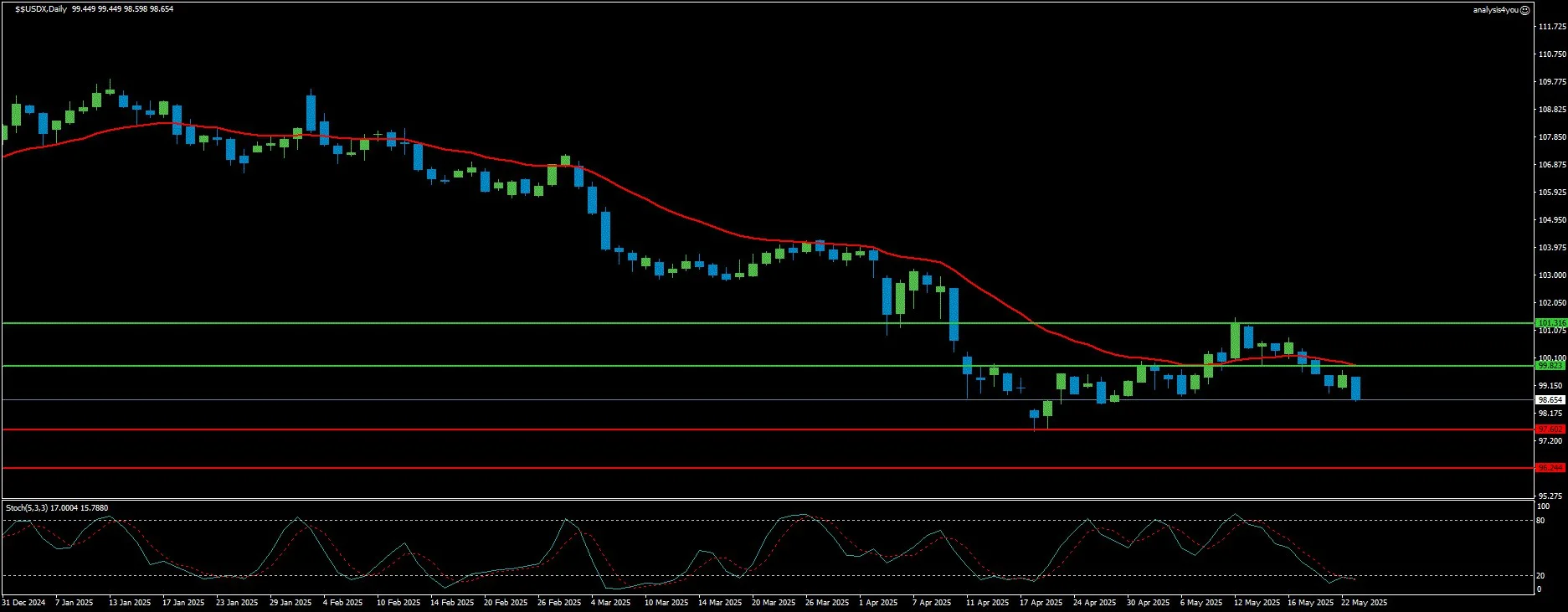
Resistance: 99.82; 101.32
Support: 97.60; 96.24
EUR/USD: Surges on Dollar Weakness (1.1380)
Current Trend: Bullish | Market Sentiment: Positive
Despite disappointing European PMI data, EUR/USD rallied to three-week highs near 1.1380, capitalizing on broad Dollar dumping. The Euro gained momentum as Trump’s 50% tariff threats on EU goods sparked safe-haven flows into EUR. However, European business activity contracted more than expected in May, with the Composite PMI falling to 49.5 from 50.4 in April. German services PMI plunged to a 30-month low of 47.2. ECB President Lagarde warned that international trade will be “changed forever” by tariff tensions.
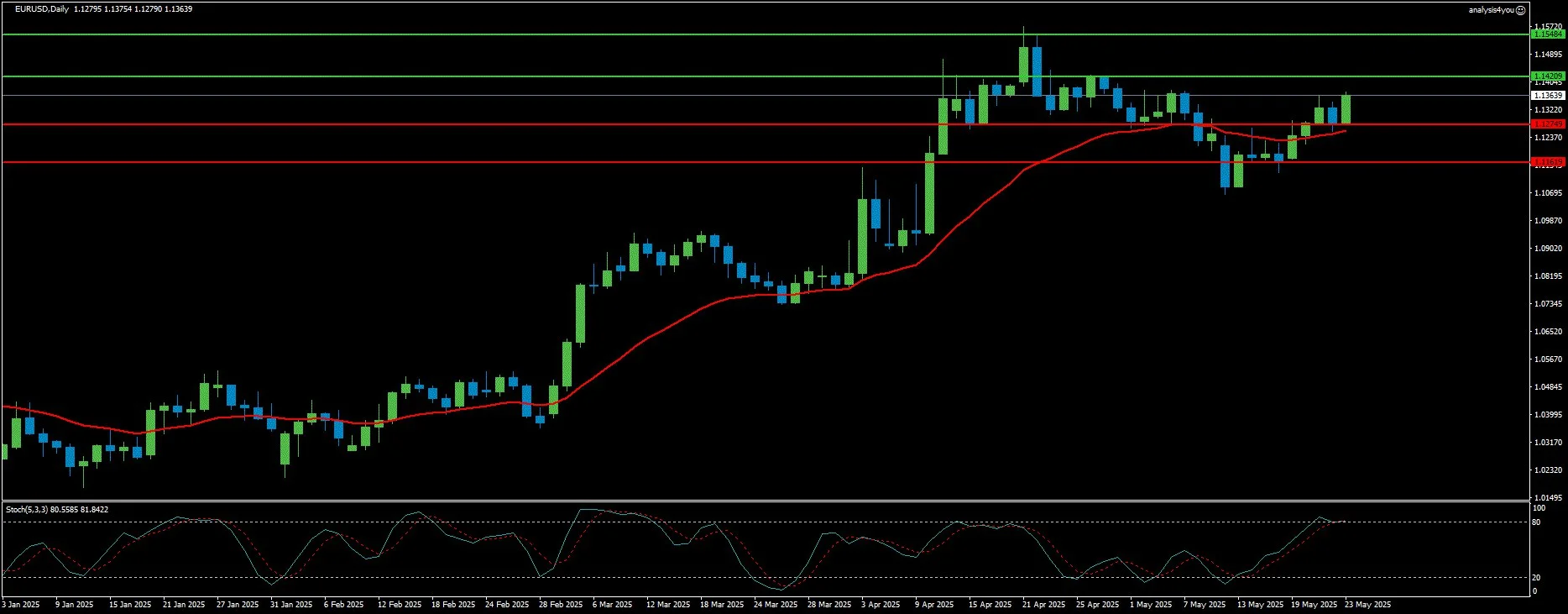
Resistance: 1.1421; 1.1548
Support: 1.1275; 1.1162
GBP/USD: Breaks Above 1.3500 Milestone (1.3520)
Current Trend: Strongly Bullish | Market Sentiment: Very Positive
GBP/USD surged past the psychological 1.3500 level for the first time since February 2022, marking its fourth consecutive month of gains. The Pound’s strength was fueled by stronger-than-expected UK inflation data (3.5% vs 3.2% expected) and robust GDP growth of 0.7% QoQ in Q1. UK 10-year gilt yields climbed above 4.80% earlier in the week before retreating. The US-UK trade deal, which includes reduced tariffs on UK vehicles and the removal of retaliatory beef tariffs, provided additional support. BoE Chief Economist Huw Pill suggested rate cuts may proceed at a quarterly pace rather than being accelerated.
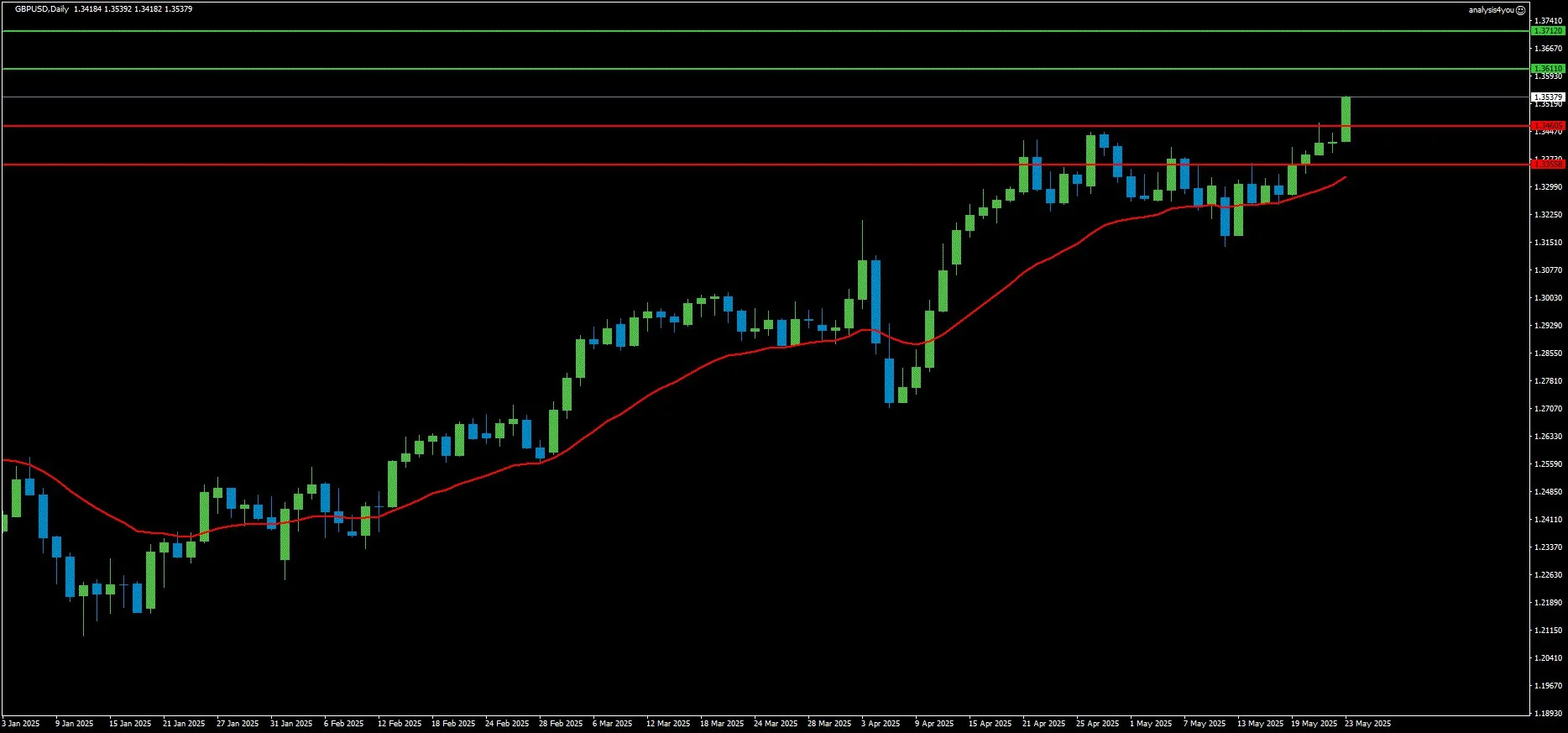
Resistance: 1.1421; 1.1548
Support: 1.1275; 1.1162
Stocks
Apple (AAPL): Under Pressure from Tariff Threats
Current Trend: Bearish | Market Sentiment: Negative
Apple shares tumbled 3% on Friday, becoming the second-worst performer in the Dow Jones, after Trump threatened 25% tariffs on iPhones manufactured outside the US. The President specifically targeted Apple’s plans to shift production from China to India rather than the US, declaring, “I don’t want you to build in India.” Wedbush analyst Dan Ives noted that producing iPhones in the US would result in retail prices around $3,500, making it economically unfeasible. Despite Apple’s commitment to spend $500 billion in the US over four years, Trump is demanding more domestic manufacturing.

Resistance: 200.49; 208.79
Support: 189.65; 181.89
S&P 500 Index: Tests 200-Day Moving Average (5,300)
Current Trend: Bearish | Market Sentiment: Cautious
The S&P 500 found support after declining 2.6% for the week on renewed trade war concerns. The index stands 20% above its April 7 52-week low but remains 5.6% below its February 19 all-time high. Markets are showing signs of fatigue after Trump’s trade policy U-turn, with JPMorgan CEO Jamie Dimon warning of “extraordinary complacency” and potential stagflation risks that could cut earnings growth to zero.
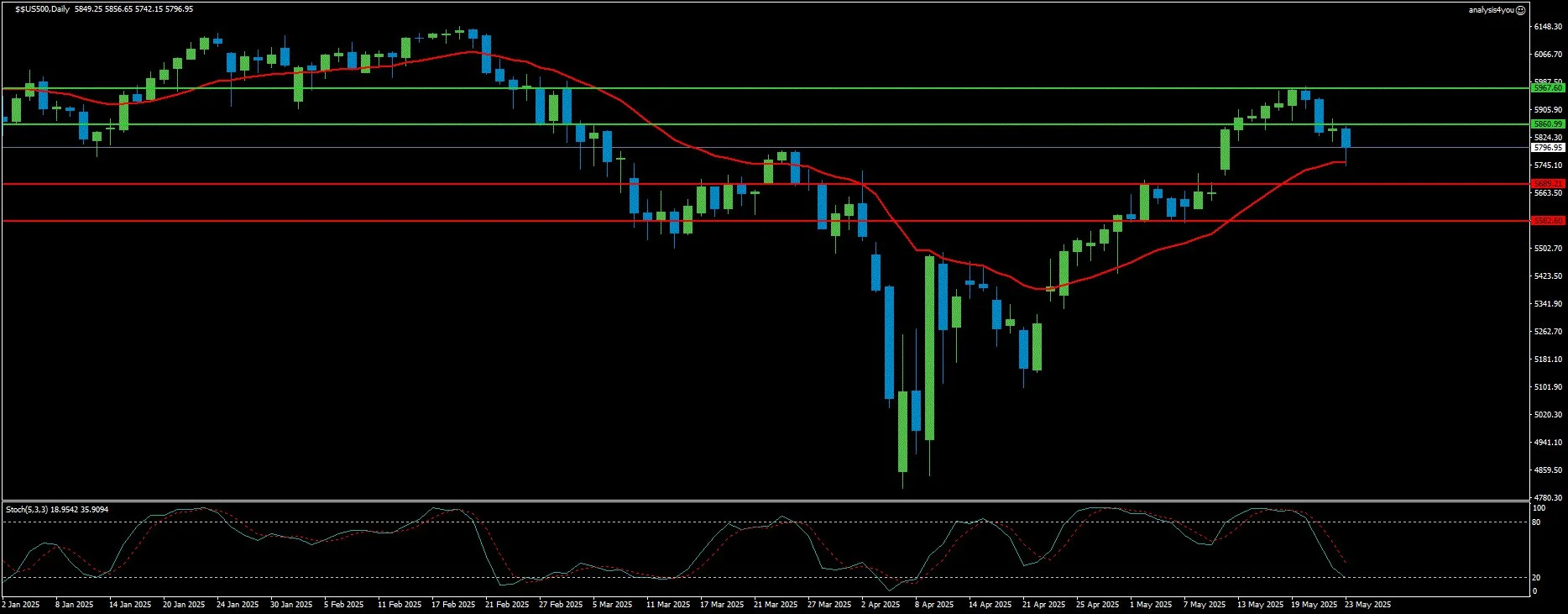
Resistance: 5860.99; 5967.60
Support: 5689.21; 5582.60
Commodities
Gold: Reclaims $3,300 on Safe-Haven Demand (3,350)
Current Trend: Bullish | Market Sentiment: Positive
Gold surged above $3,350, reclaiming the $3,300 level as safe-haven flows intensified following Moody’s US credit downgrade and escalating geopolitical tensions. The precious metal gained over 3% in the first half of the week, driven by concerns over the $36 trillion US debt pile and Trump’s proposed tax cuts that could add $3-5 billion to the deficit. Rising Middle East tensions, with reports of Israel planning strikes on Iranian nuclear facilities, provided additional support. Technical indicators suggest a bullish shift in the near-term outlook.

Resistance: 3425.40; 3498.78
Support: 3288.30; 3219.08
WTI Crude Oil: Pressured by Supply Concerns (59.90)
Current Trend: Bearish | Market Sentiment: Negative
WTI Crude Oil tested weekly lows around $59.90 heading into the Memorial Day weekend, highlighting oversupply concerns despite the start of driving season. After briefly spiking to $64.00 on Tuesday, oil quickly reversed lower as the Trump administration’s pro-energy stance continues to signal increased domestic production. The commodity has struggled to maintain sustained gains above $62.00 since late April, with technical indicators suggesting further downside pressure. The speculative range for the coming week is $58.77 – $63.70.
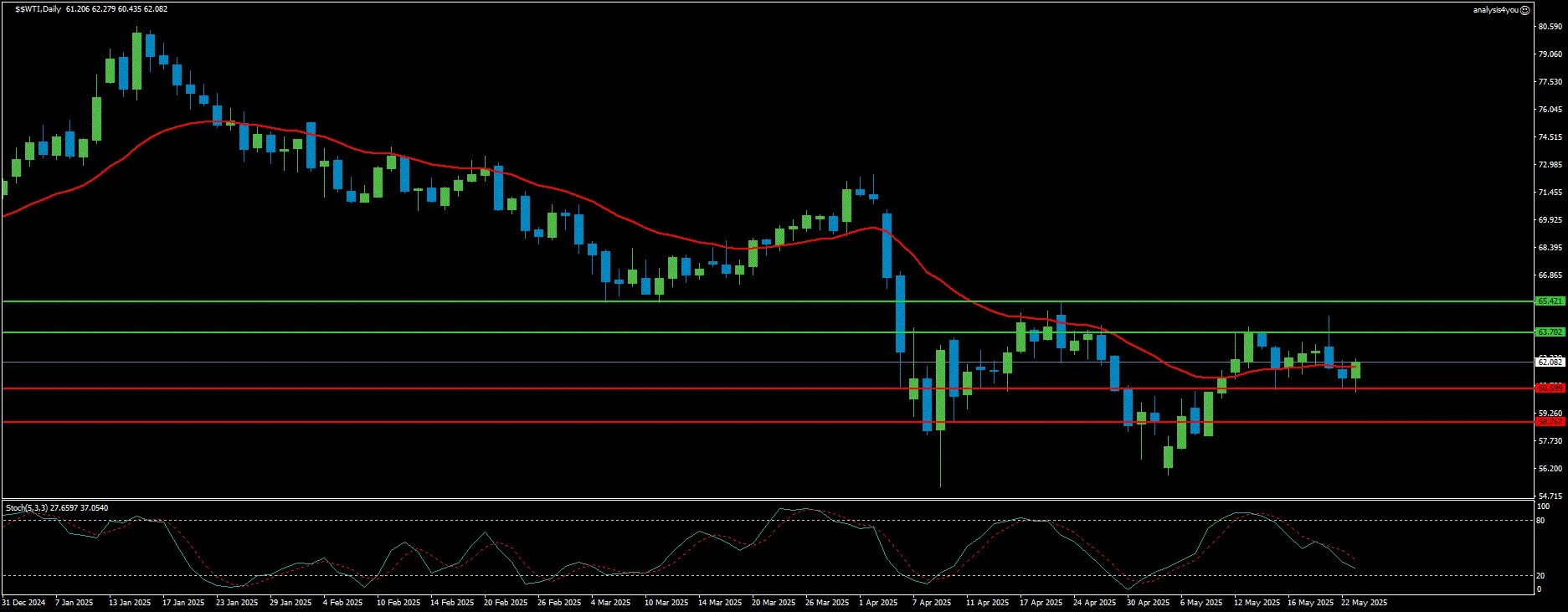
Resistance: 63.70; 65.42
Support: 60.60; 58.77
Key Events This Week (May 26-30, 2025)
- Monday: Memorial Day Holiday (US markets closed)
- Tuesday: Conference Board Consumer Confidence, Durable Goods Orders
- Wednesday: FOMC Minutes, Weekly Crude Oil Inventories (API)
- Thursday: Q1 GDP Second Estimate, Initial Jobless Claims, Pending Home Sales
- Friday: PCE Price Index (Fed’s preferred inflation gauge), Personal Income/Spending, Michigan Consumer Sentiment
Central Bank Calendar
- Wednesday: RBNZ Rate Decision (3.25% expected cut from 3.50%)
Remember to implement proper risk management strategies, particularly given the heightened volatility from trade war developments and upcoming key economic releases. The US Dollar’s sharp reversal and renewed trade tensions suggest increased market instability ahead.

